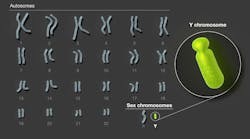Adults with a genetic form of childhood-onset blindness experienced striking recoveries of night vision within days of receiving an experimental gene therapy, according to researchers at the Scheie Eye Institute in the Perelman School of Medicine at the University of Pennsylvania.
The patients had Leber Congenital Amaurosis (LCA), a congenital blindness caused by mutations in the gene GUCY2D. The researchers, whose findings are reported in the journal iScience, delivered AAV gene therapy, which carries the DNA of the healthy version of the gene, into the retina of one eye for each of the patients in accordance with the clinical trial protocol. Within days of being treated, each patient showed large increases, in the treated eye, of visual functions mediated by rod-type photoreceptor cells. Rod cells are extremely sensitive to light and account for most of the human capacity for low-light vision.
Up to 20 percent of LCA cases are caused by mutations in GUCY2D, a gene that encodes a key protein needed in retinal photoreceptor cells for the “phototransduction cascade”—the process that converts light to neuronal signals. Prior imaging studies have shown that patients with this form of LCA tend to have relatively preserved photoreceptor cells, especially in rod-rich areas, hinting that rod-based phototransduction could work again if functional GUCY2D were present. Early results with low doses of the gene therapy, reported last year, were consistent with this idea.
The researchers used higher doses of the gene therapy in two patients, a 19- year-old man and a 32-year-old woman, who had particularly severe rod-based visual deficits. In daylight, the patients had some, albeit greatly impaired, visual function, but at night they were effectively blind, with light sensitivity on the order of 10,000 to 100,000 times less than normal.
The researchers administered the therapy to just one eye in each patient, so the treated eye could be compared to the untreated eye to gauge treatment effects. The retinal surgery was performed by Allen C. Ho, MD, a professor of Ophthalmology at Thomas Jefferson University and Wills Eye Hospital. Tests revealed that, in both patients, the treated eyes became thousands of times more light-sensitive in low-light conditions, substantially correcting the original visual deficits. The researchers used, in all, nine complementary methods to measure the patients’ light sensitivity and functional vision. These included a test of room navigation skills in low-light conditions and a test of involuntary pupil responses to light. The tests consistently showed major improvements in rod-based, low-light vision, and the patients also noted functional improvements in their everyday lives, such as “can [now] make out objects and people in the dark.”





